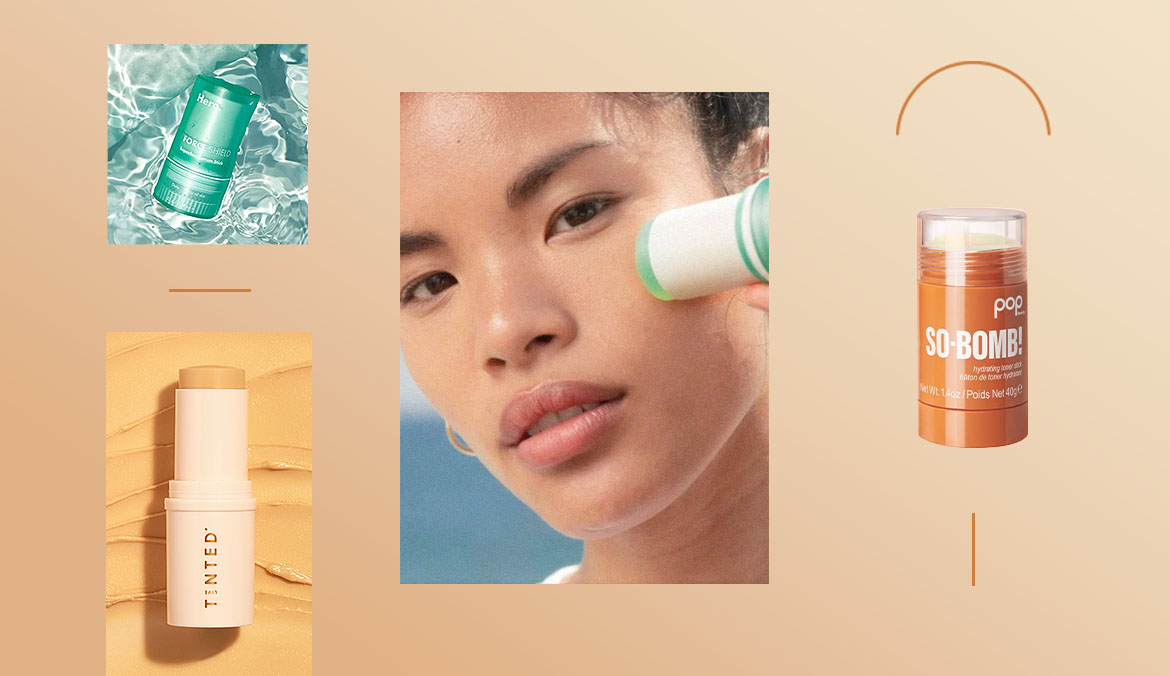The most effective skin-care products are the ones you can commit to using regularly, and a new class of serum sticks has come along to make application as easy (and fun) as possible. Some of our favorite actives are now available in Push Pop-esque form, which means you can slick on ingredients exactly where you need them without having to worry about the mess.
But while serum sticks offer a gorgeous sensorial experience and are great for targeted treatments (which explains why we’re seeing so many new launches meant for dark spots and under-eye concerns), they have certain limitations that are worth being aware of before you invest.
The benefits (and limitations) of serum sticks
Unlike traditional liquid formulas, which are water-based, serum sticks tend to be oil-based, which makes them ideal delivery systems for oil-soluble ingredients like retinoids, THD vitamin C, and vitamin E. While you can find water-based serum sticks (which typically feature water-soluble ingredients, like hyaluronic acid), oil-based offerings are more common because they’re easier to formulate in solid form.
- Caroline Robinson, MD, FAAD, board-certified dermatologist and founder of Tone Dermatology
- Javon Ford, cosmetic chemist and founder of Éclat Naturals
- Michelle Wong, PhD, Sydney, Australia-based cosmetic chemist
- Shirley Chi, MD, board-certified dermatologist specializing in medical and cosmetic dermatology
“The main difference between a stick and other products, like lotions and serums, is that a stick has less water,” says Michelle Wong, PhD, a cosmetic chemist based in Australia. “It’s generally easier to get a higher amount of an oil-soluble ingredient into a stick since there are more oil-based carriers in there.” The products typically have a waxy finish thanks to moisturizing ingredients like squalane and sunflower seed wax—two A+ picks for normal-to-dry skin types—and this waxy finish helps actives stay put when you apply them to your skin.
On the plus side, the fact that these products have less water than their liquid counterparts means that they require fewer preservatives (which can be irritating on certain skin types) to keep them fresh. “Microbes love water. They multiply a lot faster with water,” says Dr. Wong. “And so if you don’t have as much water, it’s called low-water activity. So the microbes will actually get dried out a bit by the formula.”
However, while some brands claim that the lack of water in their solid products makes active ingredients more potent, that isn’t necessarily the case: Both Dr. Wong and Javon Ford, a cosmetic chemist in Los Angeles, California, say that skin-care sticks aren’t any more potent than traditional serums and creams.
“All these ingredients have limits and just because you’re removing the water, you’re still diluting it in something,” says Ford. “In this case, you’re just replacing the water with oil. People should try them if they just like the texture and how it applies in layers onto their skin, not necessarily because it’s going to be more potent—because it’s not. There are maximum concentration limits before these ingredients get irritating. It’s not a stronger formula. It’s just it’s a different texture and sensorial feel.”
In other words: skin-care sticks are great, but they aren’t necessarily any better than the liquids and creams that are already in your routine. Deciding whether or not to use them really comes down to what sort of experience you’re looking for and what works best for your skin.
How to get the most out of your serum sticks
All of this shouldn’t sway you away from trying a serum stick (They’re fun to use! They’re mess-free! They’re easy to travel with! They make for great targeted treatments!), but there are a few things worth knowing in order to ensure you’re shopping smart and getting the most for your money.
First up, if you’re using an oil-based stick, you’ll want to look for formulas that primarily hero oil-soluble actives—like the retinoids and vitamins C and E listed above, plus squalane and an entire laundry list of skin-nourishing oils and butters (think: rosehip oil, tea tree oil, and shea butter). Since there isn’t much water in skin-care sticks, it can be tricky to make them with water-soluble ingredients like alpha-hydroxy acids (like glycolic acid) and L-ascorbic acid (the most potent form of vitamin C vitamin C). If an ingredient is water soluble and its in a liquid formula, “then it can spread out a lot better and stay dissolved,” says Dr. Wong. “Whereas in a stick form, sometimes there isn’t enough water to keep something dissolved.”
And when you find one you like, be sure to apply it exclusively to wet skin. “A solid is more likely to just sit on your skin rather than be absorbed, so you probably want to make sure your skin is a little damp [before you put it on],” says Shirley Chi, MD, a board-certified dermatologist in Southern California. She explains that when you apply products to damp skin, the water acts like a vacuum and allows the ingredients to get deeper, which can be helpful when using a solid formula.
“If you think about pharmaceuticals drugs—they’re completely made for performance—and as far as I know, none of them have sticks apart from maybe antiperspirant and wart cream,” says Dr. Wong. “But because of this stick skin-care trend, I do think there’s going to be a lot more innovations, and I’m actually quite excited to see what sorts of products come out.”
It’s a bit too soon to try and swap out your entire routine for stick products. But, with the editor-approved products below, you can try them out and see how your skin likes them.
